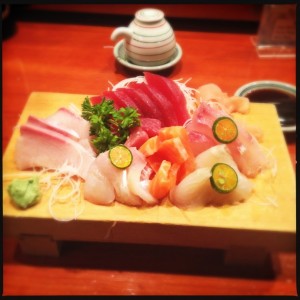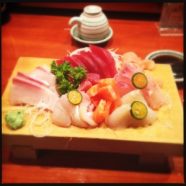Koiso Sushi Bar: Worth the Hype? (Maui Now)
 Koiso Sushi Bar in Kihei has achieved near-legendary status on this island, if only for being so freaking hard to get into.
Koiso Sushi Bar in Kihei has achieved near-legendary status on this island, if only for being so freaking hard to get into.
The tiny restaurant has seating enough for 15. This leads to scarcity and related demand. On Yelp alone, 56 people have noted the tip “make a reservation beforehand.” Take it seriously. No reservation = no love.
As for the food, this is not the place to go for vegetarian options or if you are looking for complex rolls with heavy sauces, tempura coatings or names like Volcano, Geisha, or Philadelphia.
Koiso is a spot for people who are interested in the traditional, simple Japanese-style pleasures only nigiri and sashimi can provide.
In that spirit, it makes sense to start with the Sashimi Combo ($32).
On both occasions it came with the same offering of local big eye tuna (ahi), Hamachi, King Salmon, Tai (Red Snapper), and Hirame (Flounder or Halibut).
On the first occasion, there were five slices of each fish. On the second (perhaps because of an 8:30 p.m. reservation where we weren’t even seated until 9 p.m.) things were less balanced.
The Ahi, likely because of its abundant availability locally, arrived in the largest proportion. Its incredible freshness, however, made up for it.
The Hamachi – something some of us would consume by the pound if we’re ever in a position to order a last meal – was buttery and light.
The king salmon is rich and unctuous with almost no discernible “salmon” flavor typically associated with its cooked or smoked counterparts.
The red snapper is clean and flavorful and balanced nicely with the provided calamansi halves.
The hirame was light and sweet and we found we didn’t even want to use the provided wasabi or soy sauce with any of the fish for fear of drowning out the impeccably fresh, pure flavors.
The fish is clearly of the highest quality – at least as far as can be obtained thousands of miles from Japan or even the mainland – and expertly prepared in that regard.
So what does that mean?
It’s just raw fish, right?
What makes one sushi joint better than another?
For starters – and without question – the rice.
If you’ve ever had a bad batch from the grocery store (or anywhere) where the rice was as mushy as baby food, you have a grimace on your face right now.
First, rice must be cooked perfectly, and even the same variety of rice requires differing amounts of water depending upon how old it is.
The exact amount of mirin (vinegar) is also critical, and it must be deftly added so that the grains of rice remain unbroken.
The fish is essential as well. It need to be broken down correctly and the blocks of fish needs to be shaped exactly, so when it is sliced the grain is in the correct position.
For a restaurant in the middle of the ocean like Koiso, trustworthy suppliers are also key. Arguably this is the toughest part of running a sushi restaurant anywhere that isn’t Tokyo. Hiro commented to another diner that he purchases one quarter of a fish (25 pounds) at a time from Japan, so odds are good his product is coming from the famed Tsujiki Market.
We tried the Hamachi Green Onion Roll ($9.50). It arrives with the green onions tucked inside, a lovely balance to the buttery protein. The rice is spot on, augmenting the flavors rather than distracting from them.
As for the Blue Fin Toro Nigiri ($14): blame the sake, but our notes read “Holy shit!” The rich fish literally melts in your mouth. It tastes like money… and it should at $7 a mouthful, but still.
Urged into the Akimo ($9.50) by a Japanese visitor nearby – “it’s a delicacy,” she whispered – we didn’t realize the monkfish liver was ethically in question. The potentially endangered fish (yikes) is mild with the texture of liver, but none of the flavor associated with meat or poultry organs.
The less adventurous or the sustainably clued-in may want to try a 69 roll ($19) instead. Essentially a California roll topped with eel, it’s arguably one of the better American-influenced rolls you’ll ever have. The house-prepared eel is startling airy, like eating an eel cloud.
Specialty items are often available as well.
Uni or sea urchin ($9) is also local. Plush and creamy, it’s one sea-flavored bite – and arguably an acquired taste – but the version at Koiso had us almost liking it.
On a different visit we sampled contrasting mackerels: the saba ($7) and aji ($9). The saba (jack mackerel) is oily, fishy, and a bit drier, probably what you think of when you think of mackerel. In contrast, the Aji (horse mackerel or saurel) is moist and mild.
Hiro himself is personable and friendly, and it’s intriguing to watch him quickly prepare dishes. The restaurant features just one chef and one server, and the place is tiny with weird loungey music. You might leave murmuring “it’s wonderful, it’s marvelous,” but you’ll get over it.
All in all, Koiso is worth it at least once. Save your coins and consider ordering omakase and leaving it up to the chef on your first visit.






